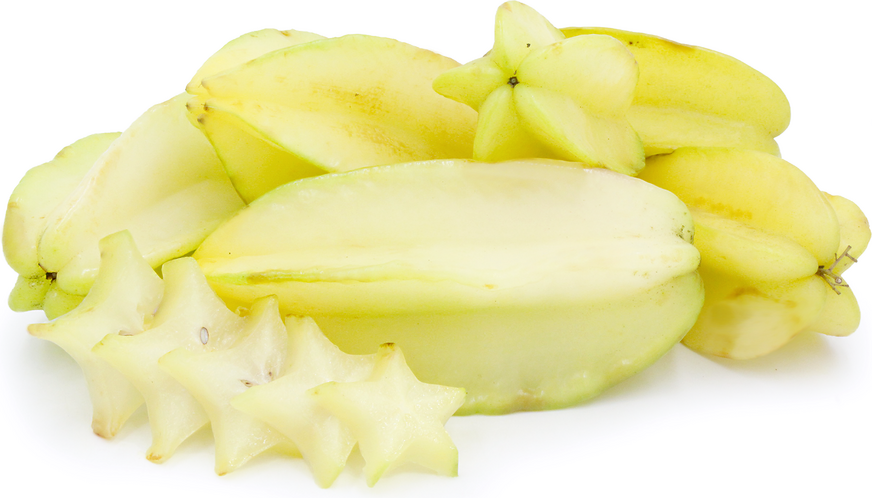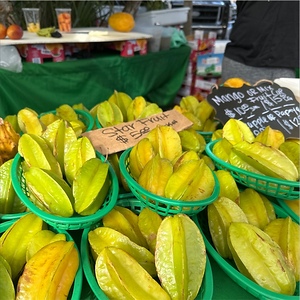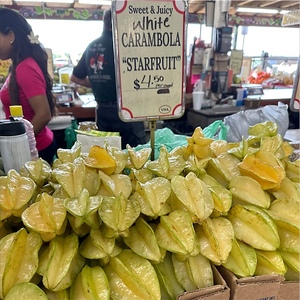


White Star Fruit
Estimated Inventory, lb : 0
Description/Taste
White Star fruit grow on multi-branched trees that have short trunks and a bushy appearance. Some varieties will reach up to 9 meters in height, while others are dwarf cultivars. White Star fruit appear on the trees following small, purple, bell-shaped flowers. The fruits average around 15 centimeters long and 7 centimeters wide. They have 5 thick ‘wings’ or deep ridges that when sliced, create a perfect 5-point star. The thin skin is a pale yellow to almost translucent color and has a slightly waxy texture. The star-shaped fruits can have anywhere from 3 to 12 small, flat brown seeds at the center, or can be entirely seedless. The skin, seeds and small core are all edible. The flesh of a White Star fruit is juicy and crisp, with a crunchy texture. They are mildly sweet, with a tropical flavor and hints of granny smith apple and a low acid content.
Seasons/Availability
White Star fruit are available year-round with a peak season in the late fall through early spring months.
Current Facts
White Star fruit is a pale cultivar known botanically as Averrhoa carambola. The star-shaped fruit is also known as Five Corner fruit or by its species name, Carambola. The white varieties with little to no green are less common, whereas the most common Star fruit cultivars are yellow with green accents along the ridges.
Nutritional Value
The sweeter White Star fruit contain at least 4% sugar, and over half the daily allowance of vitamin C. White Star fruit, like other varieties, is a good source of B-complex vitamins, potassium, zinc and iron. The tropical fruit is also rich in fiber and phytonutrient flavonoids, which offer antioxidant benefits. All Star fruit varieties contain oxalic acid, which is typically higher in the unripe, green fruits.
Applications
White Star fruit are ideal for fresh eating, though they can be used in hot applications. Trim off the edges of the wings, which may be a bit tough, and slice into thin cross-sections. Sliced White Star fruit is eye-catching and makes a nice edible garnish or topper for beverages, salads, and desserts. Add the sweet tropical fruit to fruit salads, or tarts. White Star fruit can be juiced to use in cocktails or along with other tropical fruit juices, or added to smoothies. Use White Star fruit instead of pineapple for a different take on the upside-down cake. It pairs well with other tropical fruits for chutneys and can be added to stir-fry. Preserve White Star fruits in jams or jellies. Unblemished, just ripe fruits can be refrigerated for up to 2 weeks. Most Star fruit does not freeze well.
Ethnic/Cultural Info
In Brazil and other tropical regions where Star fruit grow, the juice has been used as a folk remedy for coughs and to stimulate the kidneys.
Geography/History
Star fruit is native to Sri Lanka, the small island country off the southern tip of India, Malaysia and Indonesia. The White varieties are likely natural mutations of the yellow-fruited varieties. Star fruit trees will not tolerate weather below 27°F, and therefore require a warmer, subtropical environment to grow. They were first introduced to the Florida in the United States in the 1880s and until the 1990s were seen as more of an ornamental fruit and garnish. Early varieties grown in the United States were sour and took a while to catch on. As the global market has increased along with exports and travelers, newer, sweeter varieties were introduced. White or very pale colored Star fruit are still a rare sight in commercial markets. One White Star fruit variety, Maher, is native to Hawaii and is grown on a limited scale in Southern California.









